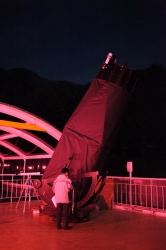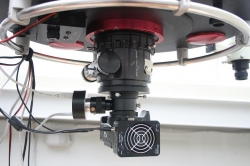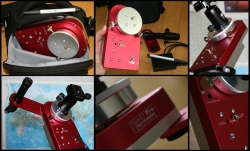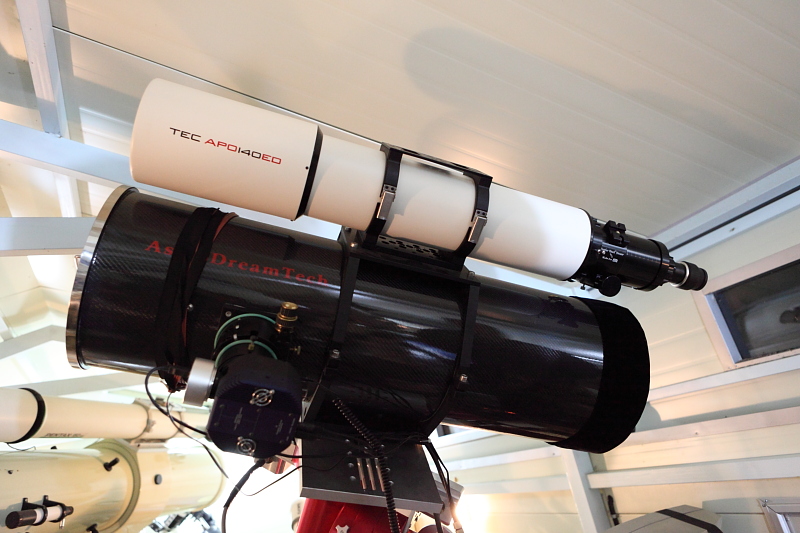

최근에 정말 우연한 인연으로 5인치급(5.1 & 5.4 인치) 굴절 망원경을 두 대 장만하게 되었습니다.
한 대는 oil spaced triplet 시장의 새 명기로 각광받는 TEC-140, 또 한대는 air spaced triplet의 리더격인 TOA-130입니다.
최근 들어 세 번에 걸쳐 두 망원경을 이리 저리 비교하여 본 결과, 재미있는 차이점들을 알게 되었는데, 왜 이런 차이가 있었는지 궁금하던 차에, 렌즈 설계 엔지니어가 쓴 장문의 글을 보고는 많은 궁금증이 해결되었습니다.
우선 제가 가졌던 의문점중의 하나는 토성을 볼 때와 별상을 볼 때의 차이점입니다.
Oil spaced triplet인 TEC-140의 경우 정확한 촛점에서는 color free한 별의 이미지를 보여주지만 정촛점에서 in focus나 특히 out focus쪽으로 포커서를 이동하면 red-violet의 수차가 눈에 잡히기 시작합니다. 물론 관측이나 촬영시에는 당연히 촛점을 잡고 진행을 하니 이게 큰 문제는 아니지만, 처음에는 저 스스로도 이거 망원경의 디자인이나 제작공정에 문제가 있는 건 아닌가하는 의문을 가져보기도 한 게 사실입니다.
그럼에도 불구하고, 실제로 토성상을 관측할 때에는 제가 느끼기에 TEC-140이 TOA-130보다 더 밝고 선명한 상을 보여주는 것입니다. 과연 이게 왜 그럴까 하는 의문에 대해, ’그건 oil s[paced triplet이 냉각이 더 빠르기 때문이지’ 라는 답을 듣고 조금은 의문이 풀렸지만, 왜 oil spaced triplet이 out focus 상태에서는 색수차를 보여주는지에 대해서는 계속 의문이 남게 됩니다.
여기에 대해 명쾌한 답을 준 것이 이 글이었는데요. 요약하면, 이렇습니다.
„Oil spaced 렌즈디자인에서는 공기와 접촉하는 최 외각의 두 렌즈 곡률이 가장 특성의 변수가 되며 내부 의 곡면들은 air spaced 렌즈디자인에 비해 상대적으로 큰 변수가 되지 않는다. 따라서 이상치에 가까운 렌즈를 생산하기에는 oil spaced 렌즈가 더 유리한 면이 있다.
그러나 air spaced triplet의 경우에는 한가지 장점이 있는데 이 경우에는 내부의 대칭적 구조로인한 자유변수들이 많아 더 넓은 간격을 가지고 거의 완전히 coma free한 렌즈를 디자인 할 수 있다. 이 경우에 디자이너는 구면수차를 개선하기위한 다른 렌즈디자인의 변수들의 희생 없이도 color correction이 자동적으로 되기 때문에 거의 완벽하게 coma correct된 렌즈를 설계할 수 있다.
그리고, 불행히도 이 것이 air spaced triplet의 단점이 되기도 하는데, 공기는 오일에 비해 약 1000배이상 열전도가 나빠 cooling이 훨씬 느리다. 그리고 구면수차 개선을 위해 space를 넓히는 추세의 최근 air spaced triplet의 경우에는 특히 중심부에 1매의 Fluorite 재질을 갖는 렌즈가 외부 렌즈보다 더 두꺼운데, 이 렌즈가 두터운 공기층의 가운데에 보온이 되고, 외부의 얇은 렌즈는 상대적으로 빨리 냉각되어 있는 상태 가 더 오래 지속된다.
반면에 oil spaced triplet은 상대적으로 빨리 냉각되고 중간의 렌즈도 빠르게 열 평형에 도달하게되는데, 실제 관측지에서의 경우 일몰후 매시간 1~2도의 온도 저하가 일어나 이러한 두 렌즈 시스템간의 차이를 더 극대화 시킨다.
물론, oil spaced lens의 경우 디자이너가 (존재하지 않는) 중간의 공기층의 간격을 늘려 내재적인 렌즈의 구면수차를 줄일 수는 없는 일이다. 따라서 oil spaced lens는 그 디자인상에서 더 최적화된 시뮬레이션 데이터나, 스팟 다이어그램 같은 air spaced triplet 망원경의 colorless한 피쳐들을 보여주지 못하는듯 하지만, 그 차이는 크지 않으며, 우리는 잘 냉각된 렌즈가 그리 잘 냉각되지 못한 시스템에 대해 보여주는 (선명도와 해상도의) 차이가 더 중요하다고 본다.
행성관측과 같은 고선명한 이미지가 중요한 영역에서 oil spaced triplet이 최근 시장에서 좋은 반응을 얻고 있는 이유이다.
Gyulai Pal
Optical Designer
GPU Optical”
이제야 두 개의 다른 방식의 triplet을 조금 잘 이해하게 된 것 같습니다. ^^
** 좀 더 자세한 원문을 보시려면 아래를 참조하세요.
If we take two, perfectly manufactured APO lenses under the stars (an air spaced one and another with oil spaces), they have to face several effects. Some of them are:
- mechanical de-centering of the lens members (as all lens cells are a bit over-sized to allow some space for the different temperature parts to move and to contract without damaging the lens)
- mechanical forces deforming the lens
- thermal problems
In the case of oil spaced lenses, mechanical de-centering of an element has very little effect on performance. The result is only some lateral color, but to make it actually visible, the lens members must be de-centered by an irrealistic value (maybe except for some extra fast focal ratios). On the contrary, de-centering the member of an air spaced lens might cause a serious coma, but it depends on the actual mechanical configuration (e.g. are there three small separate spacers between the members or spacer rings). De-centering can realistically cause problems with air spaced lenses, but it is not very common in the quality range we are inspecting, so we do not consider it to be a major problem.
Regarding mechanical forces that distort the lens members, air spaced lenses are the clear winners. If we bend a member of an air spaced lens, the two surfaces surrounding the member bend similarly, so the deformations null out each other optically. For this reason, it is enough if the cell supports the lens at three positions around the perimeter of the lens. On the contrary, in the case of oil spaced lenses, the deformation of an outer member does actually deform the wavefront (its opposite surface also bands similarly, but the internal surface can not correct the error caused by the outer surface, as the deformation of the internal surface is nulled out by the oil). So, oil spaced lenses should be supported by flexible O-rings to distribute the force evenly around the edge of the lens. This is not a problem and this effectively prevents deformations, so in this respect, the lens types are practically equal again.
But if we start to examine the different lens tipes regarding thermal problems, there will be serious differences.
The main thermal problem with air spaced lenses are the air spaces themselves. It is also a problem, that most air spaced triplet lenses have rather wide air spaces, but to understand the reason behind this, we have to take a look at some features of the air spaced doublet and triplet lenses.
Today, in the case of modern optical materials used in APO lenses, the partial dispersions of the members are very nearly matching each other, so the main source of false color is not the longitudinal chromatic aberration anymore (as it was in the case of achromats and first generation ED APOs). Now the source of false color is mostly the sphero-chromatism, i.e. the variance of spherical correction by wavelength. Today’s lenses have nearly the same focal length at every wavelength, so there is a negligible amount of false color as a result of different focal lengths at different colors. But the spherical correction of the lens still varies with wavelength, i.e. the lens is seriously under-corrected at one end of the spectrum (usually in red), and it is still over-corrected at the opposite end (in blue). As spherical correction causes part of the energy to leave the Airy disk and „move” into the diffraction rings, the diffraction rings are brigher in violet and in deep red, and the observer detects this as false color. It is true, that false color caused by sphero-chromatism has similar visual appearance (but in the case of an APO, the amount of false color is much less, if detectable at all).
It is known among optical designers, that by increasing the width of the air space, we can somehow reduce the spherochromatism of an APO lens, which actually results in a decreased amount of false color at the eyepiece.
In the case of doublet lenses, designing the air space to be wider usually results in less than optimal correction for coma, so the designer has to make a choice here: either to sacrifice part of the coma correction and make the lens more color free on the optical axis by applying a wider air space, or making the lens practically perfectly coma corrected but with a little more false color. Some companies chose to keep the lens perfectly coma corrected (most famous brands) and some chose to widen the air spaces (some producers at the Far East) in order to make the lens more color free.
But in the case of air spaced triplets, the lens has a much more symmetrical internal structure with more free parameters and it is possible to design perfectly coma corrected lenses even with wider air spaces. As in this case the improved color correction is „free of charge” (i.e. the designer does not have to sacrifice any other optical correction to improve sphero-chromatism), most air spaced triplet lenses feature rather wide (0.8-3mm) air spaces.
And unfortunately, this is the point when the optically most perfect design starts to contradict the performance of a lens under the stars. The problem is that air is a very bad heat conductor (about 1000x worse than oil), and especially if the air space is wide, the internal member of the triplet lens is separated from the environment thermally. Furhermore practically all fluoro-crown material based triplet APOs have the fluoro-crown material in the center of the lens, and the center thickness of this member is much larger than its thickness at the edge. When we take such a lens out to the cooler environment, the center member can lose only very limited amount of energy through the air spaces, but its edge is in contact with the metal cell of the lens, which cools down quickly. This way, the center of the middle element remains warm for a long time, while the edge of this middle element start to cools down suddenly. The result is undercorrection, and this remains there for a long time, because the center member loses a significant amount of energy at the edge over the entire cooling process.
On the contrary, oil spaced lenses are good heat conductors internally, so their center elements can lose a lot of heat over the front and back surfaces of the lens. So, they cool down much faster, and also, during the cooling process, the internal heat distribution of the lens is much more homogenous compared to an air spaced lens, as most of the heat is lost through the front surface and less at the lens egde. So, these optics can better and quicker adapt to the changing temperature, thus they can deliver high resolution images sooner than their air spaced brothers.
It is also true, that in the case of oil spaced lenses, the designer can not decrease the inherent spherochromatism of the lens (by widening the not existing air spaces :-), so usually an oil spaced lens features less optimal comtuper simulation data, spot diagrams and other fancy looking graphs compared to an air spaced lens. But the difference is little, and much less important than the difference of the performance of well cooled lens compared to a not-so-well-cooled system.
In applications where the most critical high resolution images are expected from a telescope (e.g. planetary observing), we believe oil spaced lenses are clearly the best choice, and the market success and excellent user reviews that similar products receive all the time do prove this theory.
Gyulai Pal
Optical Designer
GPU Optical

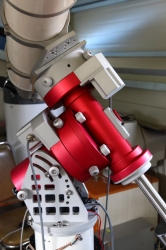 꿈의 적도의????
꿈의 적도의????
 별친구
별친구

